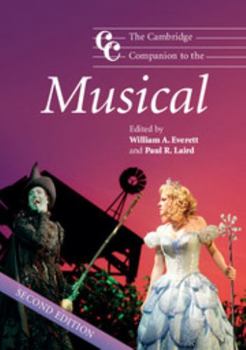The Cambridge Companion to the Musical
(Part of the Cambridge Companions to Music Series)
Select Format
Select Condition 
Book Overview
Tracing the development of the musical on both Broadway and in London's West End, this updated Companion continues to provide a broad and thorough overview of one of the liveliest and most popular... This description may be from another edition of this product.
Format:Paperback
Language:English
ISBN:0521680840
ISBN13:9780521680844
Release Date:June 2008
Publisher:Cambridge University Press
Length:432 Pages
Weight:1.90 lbs.
Dimensions:1.1" x 6.7" x 9.5"
Customer Reviews
2 ratings
This is one terrific book!
Published by AlInChgo , 3 years ago
Franz Lehar and Rudolf Friml. Victor Herbert and Jerome Kern and of course, the Gershwins. Cole Porter and Kurt Weill. Irving Berlin and Leonard Bernstein. Cy Coleman. Dorothy Fields. Rodgers and Hammerstein and who could forget Stephen Sondheim and Andrew Lloyd Webber? The list goes on and on.
Anyone can pick this book up and get a thorough grounding in American and British musicals of the Twentieth Century. I found it amazing that in just a little over 250 pages THE CAMBRIDGE COMPANION discusses so well and so amiably evolving musical styles, the major innovators, and transatlantic influences (the "British Invasion" for example). What won't you get too much of? An emphasis on economics or recorded-music technology. But the chapters devoted to Stephen Sondheim in particular are superb. Look for this book in any edition.
An excellent introduction to a vast subject
Published by Thriftbooks.com User , 21 years ago
Although my shelves are loaded with histories of the Broadway musical, there is always room for one more. So I really looked forward to reading "The Cambridge Companion to The Musical" (Cambridge University Press, 2002). When I saw there were only 265 pages of text (not counting bibliography and index), I doubted that they could adequately cover the field. Soon I began to realize that the "field" included American and British musicals, film musicals and film versions of stage musicals, and even recordings; and I just settled down to enjoy what amounts to a series of essays covering all these fields, none of them adequately but all of them interestingly. There are fourteen chapters by various writers, organized into three parts. The first deals with "Adaptations and transformations before 1940" and includes essays on the early days of the American musical theatre in general, then in New York, operetta on both sides of the Atlantic, the Afro-American as depicted on stage, and the American musicals of the 1920s and 1930s. Part II covers the years from 1940 to 1970 and discusses the British theatre, Rodgers and Hammerstein, their successors, and Weill and Bernstein. Part III picks up the story with a disproportionately long chapter on Sondheim, the fully integrated musical, the film musical, rock, and the megamusical--which brings us into the present century with a lot of questions yet to be answered by way of projection. In short, there are plenty of ideas packed into this short book and each one can lead you in several directions if you wish to follow up this or that idea. There are one or two piddling errors, such as calling "Yip Yip Yaphank" an "all-sailor vaudeville"; but in general what is said here is trustworthy, the opinions (mostly positive) about certain works and composers are informed opinions, the organization is very good. The few pictures, however, are not very helpful. Yes, I would recommend this highly for those who want to begin to understand the complex evolution of the musical play by way of enough examples to form a solid basis before going on to books that deal with each of these topics in more detailed and expanded way.






